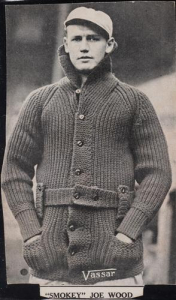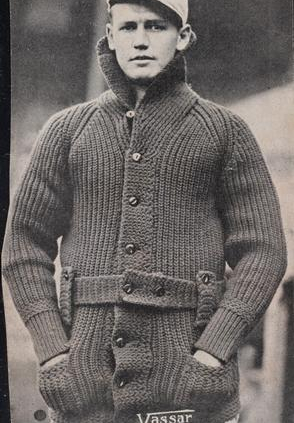July 29, 1911: Three weeks after near-miss, Boston’s Smoky Joe Wood no-hits the Browns
 Smoky Joe Wood was truly beginning to blossom as a Boston Red Sox pitcher in 1911. After reaching double-digits in wins in both 1909 (11-7) and 1910 (12-13, but with a 1.69 ERA), the 21-year-old right-hander came into his July 29 start in the first game of a doubleheader against the St. Louis Browns with a record of 17-11 and a pair of shutouts to his credit.1
Smoky Joe Wood was truly beginning to blossom as a Boston Red Sox pitcher in 1911. After reaching double-digits in wins in both 1909 (11-7) and 1910 (12-13, but with a 1.69 ERA), the 21-year-old right-hander came into his July 29 start in the first game of a doubleheader against the St. Louis Browns with a record of 17-11 and a pair of shutouts to his credit.1
Wood had faced the Browns earlier in July, on the road at Sportsman’s Park on July 7. He had taken a no-hitter into the ninth inning, but center fielder Burt Shotton singled between first and second. Wood settled for a 6-1 win, a one-hitter with a career-high 15 strikeouts. Since then, however, he had lost four of his last five decisions.2
When the Browns visited Boston in June, the June 6 game was rained out. A doubleheader at Boston’s Huntington Avenue Grounds was scheduled for Friday, July 28, but it was also rained out. The result was Saturday and Monday doubleheaders with a day off in between, in deference to Massachusetts’ prohibition of Sunday baseball.
With the rain passed on Saturday, Red Sox manager Patsy Donovan named Wood to start the first game of the first doubleheader. Browns manager (and shortstop) Bobby Wallace went with Joe Lake. Lake, like Wood, was in his fourth season, the first two with the New York Highlanders and then with the Browns. He was 7-10 coming into the game and had shut out the Washington Senators on three hits in his last outing, nine days earlier. It was Lake that Wood had beaten back on July 7.
As the end of July approached, the Detroit Tigers led the American League by 1½ games over the defending World Series champion Philadelphia Athletics. Boston was in fourth place, 14 games behind. St. Louis was in last place, already 34 games behind the leaders.3
Neither team scored in the first inning. The first St. Louis baserunner against Wood was left fielder Willie “Happy” Hogan, who drew a one-out walk in the second, but – with a hit-and-run play on – was unable to get back to first base in time when catcher Jim Stephens popped up to Wagner at short.4
The Red Sox scored once in the bottom of the second. Second baseman Heinie Wagner grounded to first baseman John Black, who tossed to pitcher Lake covering but “heaved a mile over Lake’s head.”5 Wagner took second base on the play. After a “rank throw” by catcher Stephens on a pickoff attempt, Wagner reached third base and scored easily when Boston catcher Bill Carrigan singled past shortstop.6 It was a ball that the Post-Dispatch said shortstop Wallace could have handled routinely had the infielders been in their usual positions and not playing in with a runner on third base.
Lake drew a two-out base on balls in the third inning, but nothing came of it since Shotton flied out to Speaker.
The Browns reached scoring position in the top of the fifth, after Wood hit Hogan in the ribs with a pitch. Stephens sacrificed Hogan to second base, and he took third when Black hit into an infield out. But Wood struck out Wallace, ending the inning.
In the bottom of the fifth, the Red Sox got another run. Shortstop Steve Yerkes reached on an infield hit to third base. One out later, Yerkes took second on a ball hit by right fielder Harry Hooper, which Stephens fielded and threw to first for the second out.7 Engle singled to left, a ball that Hogan almost caught. Yerkes beat Hogan’s throw home on a close play, and the Red Sox lead was 2-0.
The Red Sox scored twice in the sixth. With one out, Carrigan hustled and beat out a ball hit to short. Third baseman Larry Gardner tripled to the fence in right field and scored when left fielder Joe Riggert bounced a high hopper over the third baseman’s head.
Wood retired the Browns in order in the fifth, sixth, seventh, and eighth, making it 12 batters in a row set down after Hogan’s hit-by-pitch in the fourth. The fans present then began to root not just for a win, but for the no-hitter “with practically every rooter in the assemblage hunching hard for a clean slate.”8
Leading off the bottom of the eighth, Tris Speaker homered into the left-field bleachers. That made it 5-0.
In the ninth, Dode Criss – pinch-hitting for Lake – dumped a ball in front of the plate, pounced on and thrown to first by Carrigan. Shotton came to bat again, the same Shotton who had broken up Wood’s earlier no-hit bid in the ninth inning at the beginning of July. This time he flied out to Riggert. Wood had set down 14 straight.
The final batter was third baseman Jimmy Austin. Wood got two strikes on him. Austin then seemed to swing and miss at strike three, but he had ticked it for a foul and it had popped in and out of Carrigan’s glove. Given fresh life, he found it fleeting. On the next pitch, Austin swung and missed and Smoky Joe had his no-hitter.
Wood struck out 12 in the game, five times striking out two in the same inning. He struck out Schweitzer and Austin three times and twice struck out Shotton and Wallace. Only three outs were recorded by a Red Sox outfielder, two by Speaker in center and one by Riggert in left.
The Boston Globe declared “[T]he two other drives that had any chance to become hits were skillfully gathered in by Gardner, who was given the only hard fielding chances of the game.”9 The Post-Dispatch agreed that Wood had “shut out the Browns without a hit or anything that looked like one.”10
A couple of good defensive plays were depicted in Sid Greene’s sports-page cartoon in the Boston Journal.11
The doubleheader drew 17,596. The Browns won the second game, 5-4, in 10 innings. St. Louis scored three runs in the first, but Boston rallied to tie the game with three runs in the bottom of the ninth. A 10th-inning St. Louis run on two one-out walks and a single by Frank LaPorte allowed the Browns to escape with a split.12
Combined with his July 7 outing, the no-hitter meant that Wood had allowed just one base hit over 18 innings against the Browns and had struck out 27 in the two games combined. Perhaps it is no small wonder that the Boston Herald – three years after Cy Young’s final game with the Red Sox – had dubbed Wood “Cy Young’s successor hereabouts.”13
Wood truly did become something of a successor to Young in Boston’s pitching staff. He finished 1911 with a record of 23-17 and an ERA of 2.02. In 1912 he won 34 games against just five defeats. Ten of his wins were by shutouts, including both a one-hitter (in seven innings) and a two-hitter (in nine) against New York. He threw 35 complete games and had an ERA of 1.91. The 1912 Red Sox won the American League pennant, then the World Series against the New York Giants. Smoky Joe Wood won Game One and Game Four, was bombed for six runs in the first inning of Game Seven, but then relieved the next day and pitched the final three innings and earned the win in the clinching Game Eight.14
Acknowledgments
This article was fact-checked by Ray Danner and copy-edited by Len Levin.
Photo credit: Trading Card DB.
Sources
In addition to the sources cited in the Notes, the author consulted Baseball-Reference.com and Retrosheet.org.
https://www.baseball-reference.com/boxes/BOS/BOS191107291.shtml
https://www.retrosheet.org/boxesetc/1911/B07291BOS1911.htm
Notes
1 Both shutouts had come against the New York Highlanders – rebranded the Yankees in 1913 – four days apart on May 4 and May 8.
2 On July 19 he beat Cleveland, in Cleveland, 11-2, but worked just a third of an inning the very next day giving up a run in the bottom of the ninth in a game Boston had just tied. He then lost his next start, also in Cleveland, on July 23, 3-2 in the bottom of the 11th.
3 By season’s end, the Athletics had taken first place by a full 13½ games over the Tigers. The Browns finished last, at 41-107 and 56½ games behind the Athletics. The Red Sox were fifth, behind the White Sox, who were .5099 to Boston’s .5098.
4 The “Night Edition” of the July 29 St. Louis Star and Times carried a complete play-by-play of the game on its front page.
5 “Browns Permit Wood to Pitch a No-Hit Game,” St. Louis Post-Dispatch, July 30, 1911: 8.
6 Herman Nickerson, “Twelve Men Fan and But Two Left On,” Boston Journal, July 30, 1911: 1.
7 The lone umpire in the game was Silk O’Loughlin. The Boston Journal said he had not been able to see that the ball Hooper hit was foul and thus should not have been an out, “a strong argument in favor of the double umpire system.” Apparently, he often worked with (former Boston Americans pitcher) Bill Dinneen but Dinneen was working “the big series in Philadelphia.” A.L President Ban Johnson, however, was in the press box for this game in Boston. See “Browns Permit Wood to Pitch a No-Hit Game.”
8 R.E. McMillin, “Wood Pitches Himself into Hall of Fame,” Boston Herald, July 30, 1911: Sporting Section 1.
9 Melville E. Webb Jr., “Joe Wood Holds Browns Hitless,” Boston Globe, July 30, 1911: 1.
10 “Browns Permit Wood to Pitch a No-Hit Game.”
11 Sid Greene, “Bunches of Doings in Yesterday’s Double-Header,” Boston Journal, July 30, 1911: 8.
12 The Red Sox and Browns also split their July 31 doubleheader. In the first game of that doubleheader, Wood came out of the bullpen to record the final three outs of Boston’s 3-2 win. He was retrospectively credited with a save.
13 McMillin.
14 There had been a 6-6, 11-inning tie in Game Two, necessitating the additional game.
Additional Stats
Boston Red Sox 5
St. Louis Browns 0
Game 1, DH
Huntington Avenue Baseball Grounds
Boston, MA
Box Score + PBP:
Corrections? Additions?
If you can help us improve this game story, contact us.


